Thanks Andy. It's good to see you on here again. Sorry it's been 3 months before reaching out. I'm finding it pretty difficult to get on the finescale at all much less get any bench time in.
Gearing up
So this next segment is going to be a bit heavy to drop in some places. If I move past anything too quickly please don't be afraid to ask.
I addressed the landing gear for this kit and found that Tamiya's engineering keeps all of this pretty simple and hard to make a mess of it. I was originally going to use more PE parts here but I kept finding that they all lack any depth that is needed even at this scale. So I scratched all the add ons. Who here is surprised. With a new sharp No. 11 blade, I slowly began to carve out the features of the oleo scissors based on photos. You'll note where one is white. I apparently snipped off a pair a while back for some stupid reason and had to scratch one out. Nothing too bad. The tiny extras are built from very tiny plastic strips that I cut out with the same No. 11 blade and some pulled sprue. This all goes together with some Tamiya ETC to bond it all together without any huge blobs of glue poking out anywhere against all this tiny detail. For kicks I also carved out the bracing that folds up the gear struts. The real thing has a bit of an I-beam look about it with a flange created for stregnth. I VERY very carefully carved with a new No. 11 blade to create this space. Totally not necessary but I wanted to try it. Also, you'll note the springs that are made to look like actual springs. This was another feature I absolutely could not walk away from without owning it. A small (I think it was 0.4mm) aluminum tube (...brass would be stronger) was used as a frame while I coiled very fine silver wire...like the tiniest I could find. I kept this tight and clipped away the appropriate size needed. Boom! Springs... =]
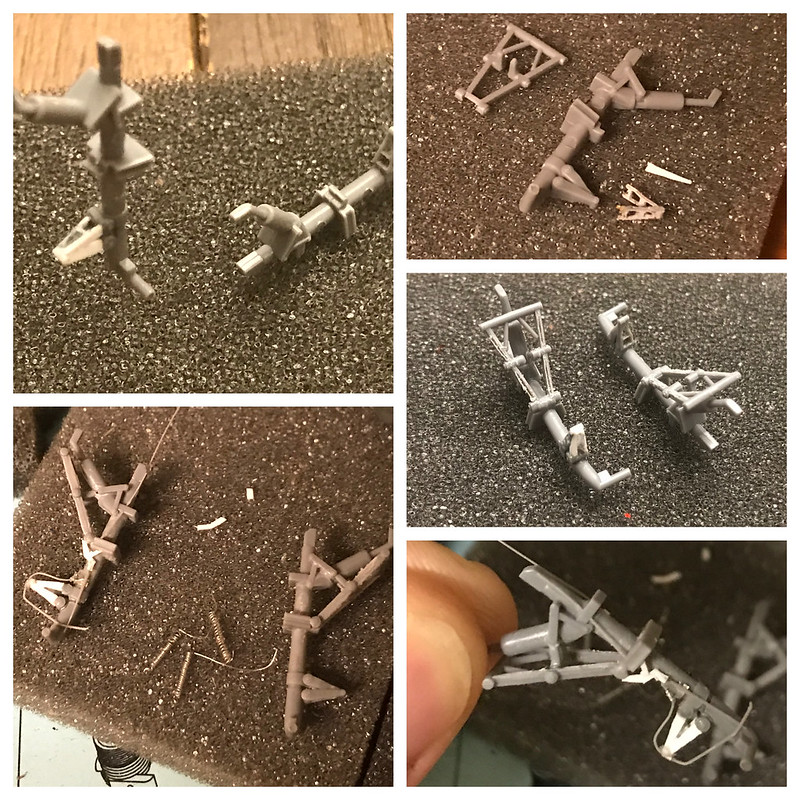 Untitled by Britt Vallot, on Flickr
Untitled by Britt Vallot, on Flickr
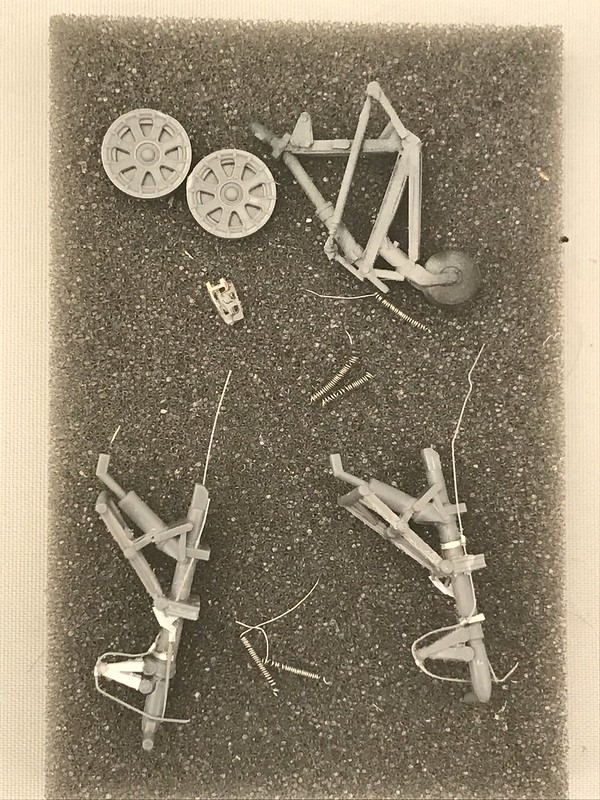 Untitled by Britt Vallot, on Flickr
Untitled by Britt Vallot, on Flickr
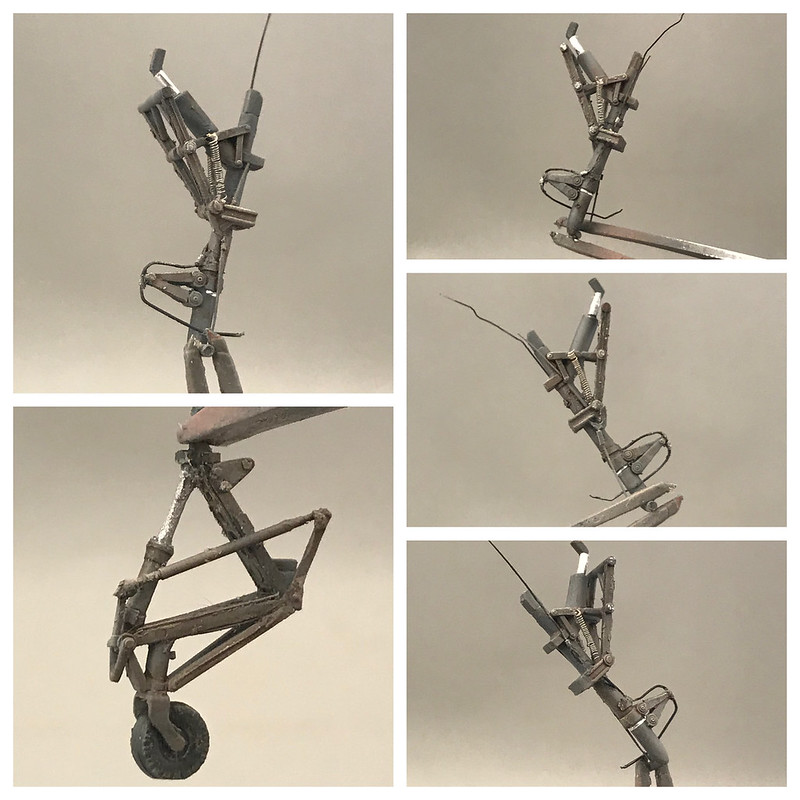 Untitled by Britt Vallot, on Flickr
Untitled by Britt Vallot, on Flickr
After primer and paint I added some thin cuts of aluminum foil to the oleo struts. I used the duller side up. It gives a more realistic look of being used and weathered. The oleo struts that Tamiya has with the kit look really weighted down. I had considered lengthening these since I won't be adding a drop tank or bombs, but honestly with the time I'm finding available I doubt I would be able to fix any problems I might create with changing it. At least not the way I'd want to go about fixing it. And Tamiya's got a great fit here so why mess with success. I do admit I conceded here. Foil also went on the top piston that retracted and lowered the gear struts.
 Untitled by Britt Vallot, on Flickr
Untitled by Britt Vallot, on Flickr
 Untitled by Britt Vallot, on Flickr
Untitled by Britt Vallot, on Flickr
 Untitled by Britt Vallot, on Flickr
Untitled by Britt Vallot, on Flickr
 Untitled by Britt Vallot, on Flickr
Untitled by Britt Vallot, on Flickr
I want to keep things in a mostly chronological order to have the flow of the build easy to follow. The doors to the gear bay came next. Riveted, primed, painted in salmon primer color, chipping solution, undersurface color, chipped, and then clear coated for weathering.
 Untitled by Britt Vallot, on Flickr
Untitled by Britt Vallot, on Flickr
One neat feature I had to include and would've missed if not for the diligence of Dana Bell in his in depth look into the Birdcage Corsair was the "Captain" "Walsh" painted on the forward gear door on the gear struts. Which reminds me I need to include a picture of that with the finished photos. This was done with a sharpened Black watercolor pencil. I'm going to add a little bit of extra weathering to this to obscure his name as seen in photos.
Weathering 2.0
I'm going to skip the obligatory clear coat pic. Just assume I did it. From the clear coat I added some extra weathering apart from what I've tried to achieve with the painting process itself. Mostly oils here that I've mixed up and thinned with a low odor thinner. I loosen it up a little more for panel lines and rivets along the center of the fuselage underside and inboard wings. A semigloss coat goes on next for better workability with oils. I apply a slightly thicker application on top for the blue-grey paint where I'm picking out the ribbing within the structure. All of this was done with the intent of being very subtle. I'm trying to keep in step with what I'm seeing in photos of the aircraft Walsh had.
 Untitled by Britt Vallot, on Flickr
Untitled by Britt Vallot, on Flickr
 Untitled by Britt Vallot, on Flickr
Untitled by Britt Vallot, on Flickr
 Untitled by Britt Vallot, on Flickr
Untitled by Britt Vallot, on Flickr
A quick look at the victory flags. I cut these out separately to leave the spacing observed in photos.
 Untitled by Britt Vallot, on Flickr
Untitled by Britt Vallot, on Flickr
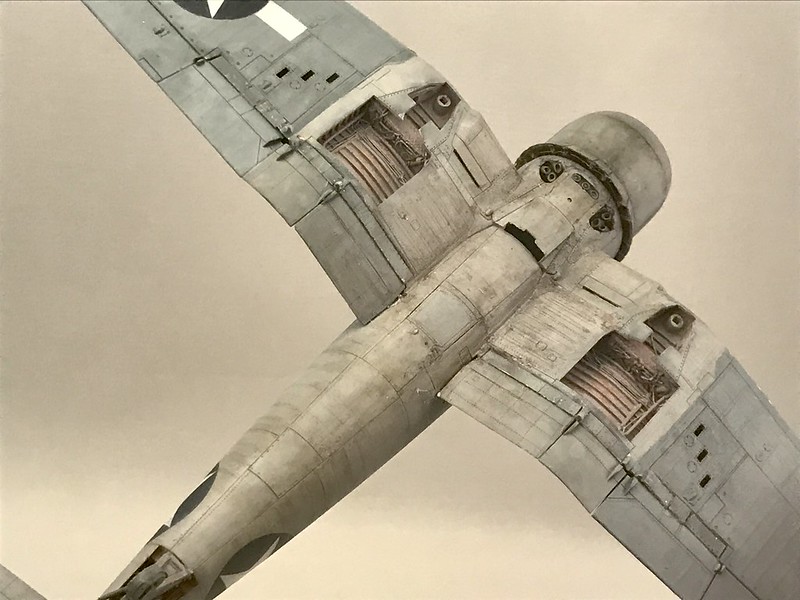 Untitled by Britt Vallot, on Flickr
Untitled by Britt Vallot, on Flickr
 Untitled by Britt Vallot, on Flickr
Untitled by Britt Vallot, on Flickr
 Untitled by Britt Vallot, on Flickr
Untitled by Britt Vallot, on Flickr
Much of what's happening hear is within the realms of normal weathering techinques.
Birdcage canopy
I turned my attention to the canopy next as I had some high hopes for making some magic here. I still have a few pictures to take of the finished canopy with the mirror and cable rigging that operated the sliding back and forth to open and close it. That'll come later. I kept with my usually black lead foil technique for interior framing. The knobs and pulley features are all scratched out of plastic rod and sanded into shape before cutting them from their original length.
Kind of explains itself.
 Untitled by Britt Vallot, on Flickr
Untitled by Britt Vallot, on Flickr
 Untitled by Britt Vallot, on Flickr
Untitled by Britt Vallot, on Flickr
 Untitled by Britt Vallot, on Flickr
Untitled by Britt Vallot, on Flickr
This all got masked with Tamiya tape on top and primed and painted. Still a few more things to show on this but I'll stop here for now.
Odds and ends
I'm beginning to wrap up loose ends here toward this stage of the build. All the big stuff is mostly complete. I turned my attention to the prop. I wanted an appropriately weathered prop for the PTO and I wanted to try again to better reveal some of what occurs with the usage and maintenance of these aircraft. I wanted a prop that wasn't straight black as that's just never the case. I wanted to see some faded greys within the already faded black as well. The last thing I decided I'd do this time around was to incorporate the oily sheen that's left from hands and fingers while turning or manuervering around the prop. So here's that.
 Untitled by Britt Vallot, on Flickr
Untitled by Britt Vallot, on Flickr
 Untitled by Britt Vallot, on Flickr
Untitled by Britt Vallot, on Flickr
I first start off by sanding down my blades to be razor thin. They don't need to be paddles. Tamiya offers a great prop already in my opinion, but it can still use some help. Primer then Alclad aluminum. I used NATO Black as it starts out as a really good faded black already and then sponge in some lighter tones to follow. If I get too far away from what I want, I can just spray on some more NATO Black to correct. Yellow tips get masked and painted. Then a clear coat for detail around the prop hub. I typically use the Detailer for spots around this. All this is sealed away in flat coat. This time I took a fine tip brush to haphazardly paint on some finger marks with a Light Sheen coat from Alclad to show a difference in reflectivity. When done right this element can add a lot of life to your subject. I've been experimenting more and more with this over my past few builds. This photo here doesn't do it justice. I'll have better pics later.
 Untitled by Britt Vallot, on Flickr
Untitled by Britt Vallot, on Flickr
I cut out the back quarter panels of glass from clear plastic sheet. I believe it's the 0.4mm thickness. I use it for things like this or for gunsight glass. Any kind of glass...it's great. I needed the same thickness for the Squadron replacement canopy otherwise it would look ridiculous. I curve the cut "glass" over the round surface of a paint brush to convince it to bend a little. =] Masked and painted.
The gunsight was addressed as well. I intended to go with the kit piece which is an early Mk.8 gunsight but of course I dropped it and could never find it again. So I made another one. Cut, sanded, glued and painted. These pictures suck and I'm sorry but I was rushing to get through some of this. They are blown up and heavily pixalated. But you get the idea.
Bringing it back to the landing gear...
I epoxied these into place so they wouldn't ever move ever. Mission accomplished! You can see how this all comes together with the little add ons to bring it more to life.
 Untitled by Britt Vallot, on Flickr
Untitled by Britt Vallot, on Flickr
 Untitled by Britt Vallot, on Flickr
Untitled by Britt Vallot, on Flickr
 Untitled by Britt Vallot, on Flickr
Untitled by Britt Vallot, on Flickr
 Untitled by Britt Vallot, on Flickr
Untitled by Britt Vallot, on Flickr
Signal light cut off, reformed from clear sprue.
 Untitled by Britt Vallot, on Flickr
Untitled by Britt Vallot, on Flickr
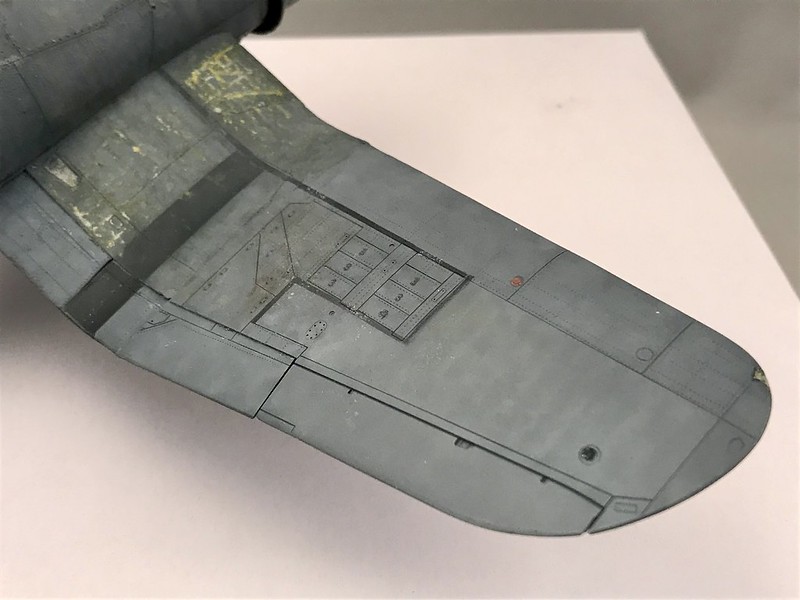 Untitled by Britt Vallot, on Flickr
Untitled by Britt Vallot, on Flickr
 Untitled by Britt Vallot, on Flickr
Untitled by Britt Vallot, on Flickr
 Untitled by Britt Vallot, on Flickr
Untitled by Britt Vallot, on Flickr
Exhaust stains added. I stopped at this fuselage vent as I've noticed over and over again how this deflected a considerable amount of engine soot and lead staining along the undersurface of the fuselage. I tapered a small amount that I let find it's way along the wing root and kept that lightly down toward the tail.
 Untitled by Britt Vallot, on Flickr
Untitled by Britt Vallot, on Flickr
Getting closer!! =]
 Untitled by Britt Vallot, on Flickr
Untitled by Britt Vallot, on Flickr